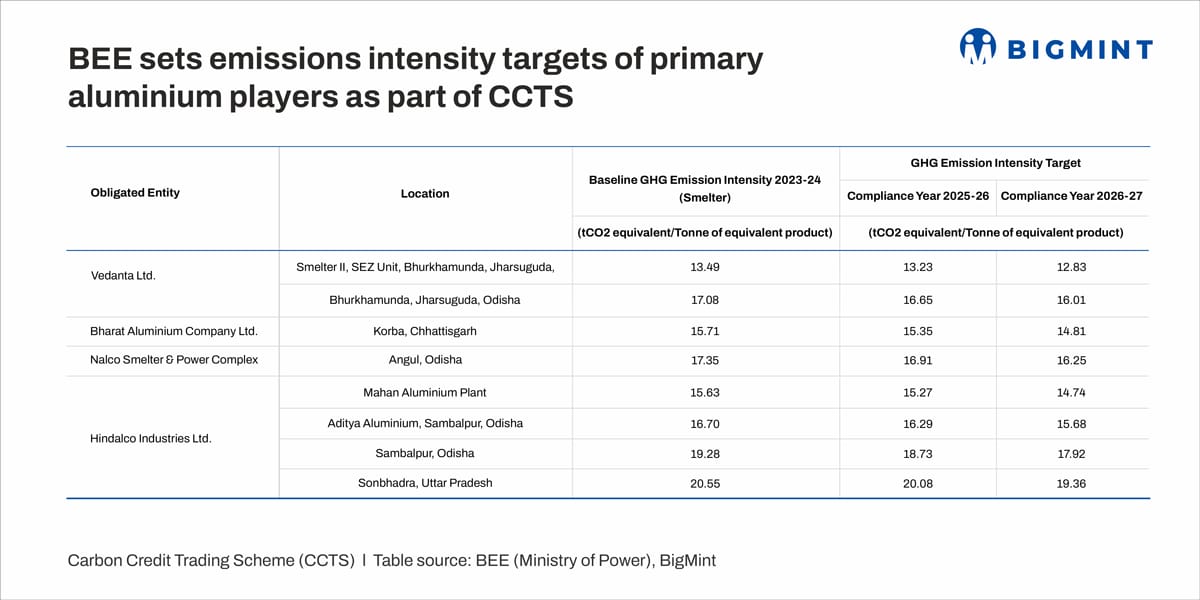Posted on 20 May 2025

Morning Brief: The Bureau of Energy Efficiency (BEE) under the Ministry of Power, the nodal agency for India's emerging carbon market, has recently published the Greenhouse Gases Emission Intensity Target Rules, 2025 for stakeholder consultation. India's Carbon Credit Trading Scheme (CCTS), notified on 28 June, 2023, seeks to establish a carbon market framework for trading of the carbon credit certificates to reduce or remove or avoid greenhouse gases emissions.
Under the compliance mechanism of CCTS, greenhouse gases emission intensity targets for the obligated entities are to be notified by the Ministry of Environment, Forest, and Climate Change. In the recently published draft notification, the BEE has set these targets for obligated entities across four sectors -- aluminium (smelting and refining), cement, chlor alkali and pulp and paper -- with different sub-sectors under each sector.
The GHG intensity targets have been fixed for FY'26 and FY'27 against the baseline of FY'24. Under the compliance mechanism of the CCTS, the GHG intensity targets are required to be fulfilled by the obligated entities.

Aluminium sector targets
The obligated entities in the aluminium sector comprise all primary players in the country--Hindalco, Vedanta, state-owned NALCO, as well as BALCO in which Vedanta holds a major stake. The schedule attached to the BEE notification mentions the emissions intensity baseline (FY'24) and the targets for FY'26 and FY'27.
The aluminium sector is divided into two sub-sectors: smelting and refining. Notably, India's average carbon intensity is around 18 tCO2e/t of aluminium, owing to usage of coal linkage and captive coal mines. The global average is 15.1 tCO2e/t which means that the average GHG intensity of the top domestic primary aluminium producers is much higher.
Smelting of aluminium is by far the most energy intensive process and is responsible for the bulk of emissions in primary aluminium (see table). In order to achieve the emission intensity targets, domestic manufacturers will have to adopt new technologies as well as non-fossil electricity, which is the key source of emissions.
Compliance structure
The obligated entities have to meet the emission intensity targets for the respective compliance year by purchasing carbon credits certificates from the Indian carbon market. "In case of not achieving the prescribed GEI (intensity) target, the entities will have to submit the banked carbon credit certificates or carbon credit certificates purchased in the current compliance year equivalent to the shortfall to comply with the GEI target in the respective compliance year," the notification says.
The companies mentioned have to register on the Indian Carbon Market (ICM) Portal within the timeline and in the manner as stipulated by BEE. Companies are liable to pay penalty, in case of non-compliance, against the shortfall in the respective compliance year.
Saurabh Diddi, Director of BEE, had informed during an exclusive BigMint webinar recently that the price of carbon credits in India should be in the vicinity of $8-10/t at least and entities that leverage breakthrough technologies and reduce emissions can directly monetise by selling credits in the market.
Source:BigMint